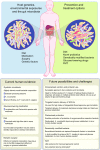The gut microbiome as a target for prevention and treatment of hyperglycaemia in type 2 diabetes: from current human evidence to future possibilities
- PMID: 28434033
- PMCID: PMC5423958
- DOI: 10.1007/s00125-017-4278-3
The gut microbiome as a target for prevention and treatment of hyperglycaemia in type 2 diabetes: from current human evidence to future possibilities
Abstract
The totality of microbial genomes in the gut exceeds the size of the human genome, having around 500-fold more genes that importantly complement our coding potential. Microbial genes are essential for key metabolic processes, such as the breakdown of indigestible dietary fibres to short-chain fatty acids, biosynthesis of amino acids and vitamins, and production of neurotransmitters and hormones. During the last decade, evidence has accumulated to support a role for gut microbiota (analysed from faecal samples) in glycaemic control and type 2 diabetes. Mechanistic studies in mice support a causal role for gut microbiota in metabolic diseases, although human data favouring causality is insufficient. As it may be challenging to sort the human evidence from the large number of animal studies in the field, there is a need to provide a review of human studies. Thus, the aim of this review is to cover the current and future possibilities and challenges of using the gut microbiota, with its capacity to be modified, in the development of preventive and treatment strategies for hyperglycaemia and type 2 diabetes in humans. We discuss what is known about the composition and functionality of human gut microbiota in type 2 diabetes and summarise recent evidence of current treatment strategies that involve, or are based on, modification of gut microbiota (diet, probiotics, metformin and bariatric surgery). We go on to review some potential future gut-based glucose-lowering approaches involving microbiota, including the development of personalised nutrition and probiotic approaches, identification of therapeutic components of probiotics, targeted delivery of propionate in the proximal colon, targeted delivery of metformin in the lower gut, faecal microbiota transplantation, and the incorporation of genetically modified bacteria that express therapeutic factors into microbiota. Finally, future avenues and challenges for understanding the interplay between human nutrition, genetics and microbial genetics, and the need for integration of human multi-omic data (such as genetics, transcriptomics, epigenetics, proteomics and metabolomics) with microbiome data (such as strain-level variation, transcriptomics, proteomics and metabolomics) to make personalised treatments a successful future reality are discussed.
Keywords: 16S sequencing; Faecal microbiome; Genetics; Glycaemic control; Gut microbiome; Metagenomics; Metformin; Personalised nutrition; Probiotics; Review; Type 2 diabetes.
Conflict of interest statement
Funding
MO-M is a recipient of grants from the Swedish Research Council, the Swedish Heart and Lung Foundation, the Novo Nordic Foundation, the Swedish Diabetes Foundation, the Region Skåne (Skåne University Hospital) and the European Research Council (Consolidator grant no. 649021, Orho-Melander).
Duality of interest
The authors declare that there is no duality of interest associated with this manuscript.
Contribution statement
Both authors were responsible for drafting the article and revising it critically for important intellectual content. Both authors approved the version to be published.
Figures

References
Publication types
MeSH terms
Substances
LinkOut - more resources
Full Text Sources
Other Literature Sources
Medical
Research Materials

